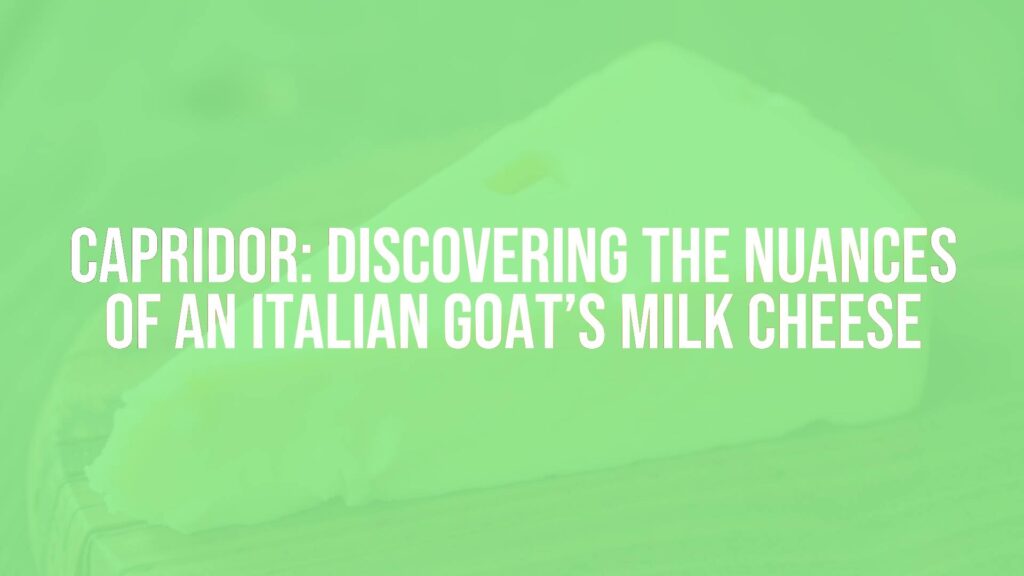Understanding Capridor: An Italian Goat Cheese Gem
Capridor is a lesser-known but intriguing Italian cheese, celebrated for its distinctive character and unique blend of flavors. Made exclusively from goat’s milk, Capridor stands apart among Italian cheeses through its creamy texture, complex aromas, and the finesse imparted by traditional craftsmanship. Its rising fame among gourmets and chefs can be traced to its ability to be both delicate and assertive, making it an alluring choice for cheese aficionados seeking something outside Italy’s more famous offerings.
A Glimpse Into Capridor’s History and Origins
While not as ancient as some Italian cheese varieties, Capridor has roots in rural cheese-making traditions that utilize the region’s abundant goat herds. The name itself, drawing on “capra” (goat) and “d’oro” (of gold), hints at both the milk source and the golden value this cheese brings to the table. Production of Capridor gained traction in mountainous and hilly areas where goats thrive, especially in the northern and central countryside, often in family dairies or small cooperatives. Over time, its creamy yet tangy profile has garnered appreciation in Italian markets and, increasingly, abroad.
Crafting Capridor: Traditional Production Techniques
Capridor is produced using fresh, high-quality goat’s milk sourced from local herds grazing on wild grasses and herbs, which subtly influences the cheese’s flavor profile. The cheese is traditionally made by gently heating the milk, adding natural rennet, and allowing it to curdle slowly. After the curds are set, they are carefully ladled into molds, pressed, and salted to promote the development of the rind and enhance preservation. Capridor is typically aged for several weeks, but some versions are matured for longer, leading to deeper flavors and firmer texture.
Flavor Profile and Characteristics
One of Capridor’s standout features is its mild creaminess balanced by a delicate tang, a hallmark of well-crafted goat’s cheese. Its pale ivory body is smooth and supple when young, becoming slightly firmer and crumbly as it matures. The rind, often natural or lightly washed, adds subtle earthy notes. Aromatically, Capridor often reveals grassy and herbal nuances, reflecting the goat’s diet, accompanied by a clean, lactic scent that never overwhelms the palate.
Culinary Uses and Traditional Pairings
Capridor excels both as a table cheese and as an ingredient in various dishes. It is traditionally enjoyed on its own, sliced with rustic bread or crostini, and pairs elegantly with local honey, fresh figs, or lightly salted nuts. Its creamy consistency makes it a wonderful addition to antipasti platters or salads, where it complements crisp vegetables and fresh herbs. In cooked meals, Capridor melts beautifully, lending its subtle tartness to savory tarts, pastas, or vegetable gratins. For beverage pairings, light, aromatic white wines, young reds, or even sparkling varieties are often recommended to highlight the cheese’s bright flavors.
Regional Variations and Modern Appreciation
While Capridor retains a consistent character, subtle regional differences can emerge depending on the type of goat, the lushness of local pastures, and aging practices. Some versions may feature an ash-dusted rind or be rolled in aromatic herbs for added complexity. Contemporary Italian cheesemakers also experiment with aging techniques or blending with cow’s milk, but traditionalists favor the pure goat’s milk variety for its authentic flavor and texture.
Serving Suggestions and Enjoyment Tips
To make the most of Capridor’s flavors, serve it at room temperature, allowing its aromas and texture to fully develop. It shines on a cheese board with accompaniments that balance its tang—think dried apricots, walnuts, or a drizzle of acacia honey. For a true taste of regional Italy, pair Capridor with a slice of rustic sourdough and a glass of chilled Verdicchio or a young Nebbiolo. Whether at the start or end of a meal, this cheese offers a refined, versatile experience, perfect for those looking to broaden their appreciation of Italy’s extraordinary cheese culture.

